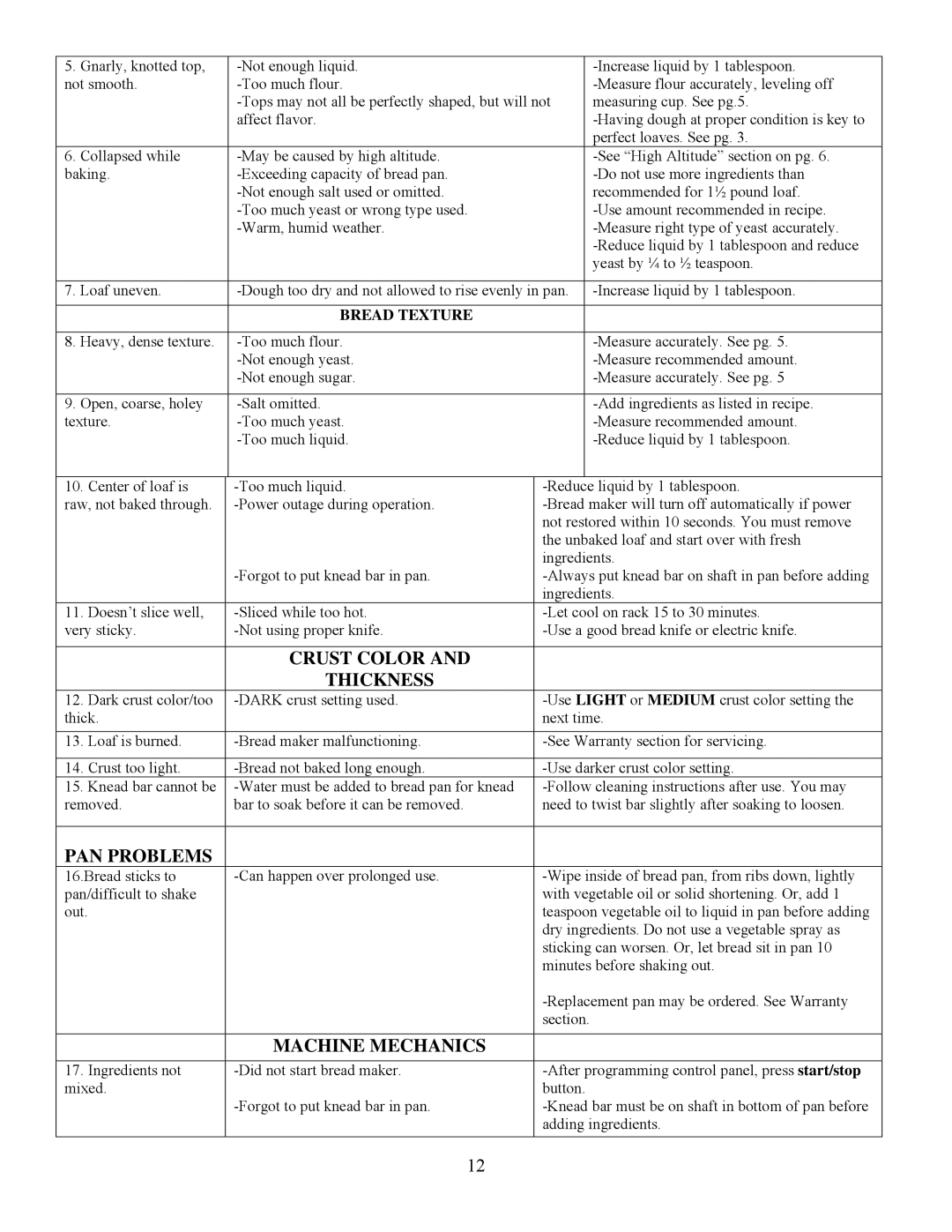5. Gnarly, knotted top, | -Not enough liquid. | | | -Increase liquid by 1 tablespoon. |
not smooth. | -Too much flour. | | | -Measure flour accurately, leveling off |
| -Tops may not all be perfectly shaped, but will not | | measuring cup. See pg.5. |
| affect flavor. | | | -Having dough at proper condition is key to |
| | | | perfect loaves. See pg. 3. |
6. Collapsed while | -May be caused by high altitude. | | | -See “High Altitude” section on pg. 6. |
baking. | -Exceeding capacity of bread pan. | | | -Do not use more ingredients than |
| -Not enough salt used or omitted. | | | recommended for 1½ pound loaf. |
| -Too much yeast or wrong type used. | | | -Use amount recommended in recipe. |
| -Warm, humid weather. | | | -Measure right type of yeast accurately. |
| | | | -Reduce liquid by 1 tablespoon and reduce |
| | | | yeast by ¼ to ½ teaspoon. |
| | | | |
7. Loaf uneven. | -Dough too dry and not allowed to rise evenly in pan. | | -Increase liquid by 1 tablespoon. |
| | | | |
| BREAD TEXTURE | | | |
| | | | |
8. Heavy, dense texture. | -Too much flour. | | | -Measure accurately. See pg. 5. |
| -Not enough yeast. | | | -Measure recommended amount. |
| -Not enough sugar. | | | -Measure accurately. See pg. 5 |
| | | | |
9. Open, coarse, holey | -Salt omitted. | | | -Add ingredients as listed in recipe. |
texture. | -Too much yeast. | | | -Measure recommended amount. |
| -Too much liquid. | | | -Reduce liquid by 1 tablespoon. |
| | | |
10. Center of loaf is | -Too much liquid. | -Reduce | liquid by 1 tablespoon. |
raw, not baked through. | -Power outage during operation. | -Bread maker will turn off automatically if power |
| | not restored within 10 seconds. You must remove |
| | the unbaked loaf and start over with fresh |
| | ingredients. |
| -Forgot to put knead bar in pan. | -Always put knead bar on shaft in pan before adding |
| | ingredients. |
11. Doesn’t slice well, | -Sliced while too hot. | -Let cool on rack 15 to 30 minutes. |
very sticky. | -Not using proper knife. | -Use a good bread knife or electric knife. |
| | | | |
| CRUST COLOR AND | | | |
| THICKNESS | | | |
12. Dark crust color/too | -DARK crust setting used. | -Use LIGHT or MEDIUM crust color setting the |
thick. | | next time. |
| | |
13. Loaf is burned. | -Bread maker malfunctioning. | -See Warranty section for servicing. |
| | |
14. Crust too light. | -Bread not baked long enough. | -Use darker crust color setting. |
15. Knead bar cannot be | -Water must be added to bread pan for knead | -Follow cleaning instructions after use. You may |
removed. | bar to soak before it can be removed. | need to twist bar slightly after soaking to loosen. |
| | | | |
PAN PROBLEMS | | | | |
16.Bread sticks to | -Can happen over prolonged use. | -Wipe inside of bread pan, from ribs down, lightly |
pan/difficult to shake | | with vegetable oil or solid shortening. Or, add 1 |
out. | | teaspoon vegetable oil to liquid in pan before adding |
| | dry ingredients. Do not use a vegetable spray as |
| | sticking can worsen. Or, let bread sit in pan 10 |
| | minutes before shaking out. |
| | -Replacement pan may be ordered. See Warranty |
| | section. | |
| | | | |
| MACHINE MECHANICS | | | |
17. Ingredients not | -Did not start bread maker. | -After programming control panel, press start/stop |
mixed. | | button. | |
| -Forgot to put knead bar in pan. | -Knead bar must be on shaft in bottom of pan before |
| | adding ingredients. |
